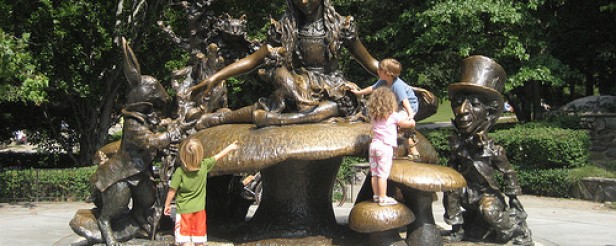By Phin Upham
A statue lives in the heart of Central Park in New York city that has been touched and worn down by thousands if not millions of children, the bronze “Alice in Wonderland.” Today, Friday afternoon in March, a young boy is climbing the statue, making his way over the large mushroom and around the Mad Hatter. After stepping on the White Rabbit’s hat, he finally gets to his destination, Alice’s shoulders, where he comfortably sits within a fairytale. I enjoyed climbing the same statue when I was a small boy living in New York City – I had so much fun. The statue is a jungle-gym of the New York imagination.
The climbable image conjures Lewis Carroll’s stories and takes one from our material world and into a world of shared imagination. Despite race, culture, or ethnicity, many New Yorkers have a special connection to “Alice in Wonderland.” Around 73rd Street nearby the boating pond in Central Park, the statue is easily viewable from all sides due to its mostly round shape. It stands fifteen feet tall by twenty feet wide and features the main characters from Lewis Carroll’s book “Alice in Wonderland,” including the White Rabbit, the Mad Hatter, and, of course, Alice seated on a giant mushroom. Nearly ten feet tall, the largest character is Alice.
The statue has been touched and climbed on so often that most of its brown, matte patina hue has been polished to a bright gold. When it comes to appreciating art, touch is rarely part of the picture. Something that is felt and climbed on is usually part of a landscape. This interaction between the sculpture and the viewer leaves an imprint on both the viewer and the viewed. Every single day hundreds of kids get to climb on “Alice in Wonderland.” The participation between the sculpture and its observers makes the sculpture seem unfinished when it is not adorned with at least a few kids playing, climbing, and hanging on it.
Lewis Carroll’s fairytale of Alice is familiar to most adults and children. They have either read the tale or inquire about it when the visit the statue. The sculpture provides a way for them to physically step into and interact with a world that might have only existed on the page or in their minds. The statue is a beloved piece of art work in New York – it is appreciated by children from a broad range of backgrounds, races, and religions.
Art is something everyone aspires to climb, whether spiritually or physically. It is climbable as we strive to grasp the artist’s intentions. Although we might not climb upward, we do climb art inward and outward. According to historian Brice Marden, art can help us understand as much about our inner nature as we understand about the world outside of us. Marden goes on to say that art reflects human nature and creates a magical “communalism, a brotherhood and sisterhood” that goes beyond “culture, or race.”
Public, communal projects can bring people together during difficult times when we set our mind to appreciate such shared experiences. And one of the best examples of a communal project that has the power to do just that is the “Alice in Wonderland” statue in New York’s Central Park.
————————————————————————————–
 Article by Phin Upham. Phin Upham is an investor and formerly a journalist and editor. Visit Phin Upham’s photography site and contact him at Phin Upham Facebook.
Article by Phin Upham. Phin Upham is an investor and formerly a journalist and editor. Visit Phin Upham’s photography site and contact him at Phin Upham Facebook.
